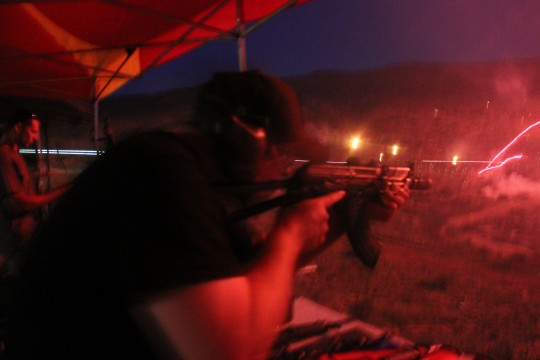It's 3 P.M. on a Friday and I'm in the Arizona desert holding a fully automatic short barreled Vietnam-era Colt M16A1. I'm running toward a trench. As I jump into the trench I load a 30-round magazine into the gun, hit the bolt release, and start firing.
I get the first two shots on a close-in cardboard target immediately. However, the automatic rate of fire combined with the short barrel configuration make hitting the mid-range steel target a real challenge. It takes an extra burst to clear it.
As I move on to the second stage of the match I can feel the breeze rushing over the sweat on my forehead and it provides a nice relief from the intensity of the desert sun. But it doesn't help me shoot any better. I easily clear the close-in cardboard target with a quick burst of fire. After that I let go several bursts trying to clear the steel.
Shooting from an upright stance clearly isn't working so I try to brace the gun against the top of the trench. That doesn't work either and I eat through the rest of the ammo in the magazine before I know it. I'm forced to reload with more than half of the course to go.
It takes two more bursts but I finally get the second strike on the steel plate. I run on to the next station, doing my best not to fall flat on my face, and put two shots on the cardboard once I arrive. The steel goes down a little easier this time, two bursts and I'm through to the final station.
Then things get really interesting. For the last station I have to switch the gun from my natural right hand to my left hand and shoot both the cardboard and steel targets. Four hits while shooting left-handed with a short barreled M16A1 with the selector switch firmly on "full?" Come on.
Thankfully, I breeze through the cardboard targets once again. I lean up against the side of the trench once more to steady the gun. I pull the trigger but only one round goes off.
Am I out of ammo? No, the gun is jammed. After a few precious seconds of fumbling with the gun, I clear the jam and get the gun back on target. It still takes another five shots to finish off the match but I am able to finish.
The winner of the match did it with an English Bren Gun which weighs over 22 pounds and fires the 150 grain .303 British round (compared to my M16A1 which weighs around 7 pounds and fires the 55 grain 5.56 NATO round). But, hey, I still completed the course and had a ton of fun doing it.
I'm at the Big Sandy Machine Gun Shoot in Wikieup, Ariz. It's a 10-square-mile patch of desert that sits almost exactly at the midpoint in between Las Vegas and Phoenix. Sometimes its extensive trail system is used for dirt bike races. More often the site is used for training by police and special operations forces. Chris Kyle even trained in long distance shooting here on several occasions.
Twice a year it transforms into the largest machine gun festival in the country. There are dozens of RVs and tents, hundreds of shooters, thousands of spectators, thousands of guns, fireworks as targets, explosives as targets, RC planes as targets, and hundreds of thousands of rounds of ammunition. It goes on from the break of dawn until it's well past dark. And I spent three days right in the middle of it all.
The shoot is run by Ed Hope, Kenton Tucker, and a dozen or so staff members. Kenton and Ed take care of booking the shooters and sponsors, and the rest of the staff does everything from officiating matches, to ensuring the safety of the range, renting machine guns, and setting up the explosive targets.
They're all kept pretty busy: supervising the tracer fire, dynamite, and fireworks laden night shoots, hauling the lifesize Tie Bomber replica, complete with Darth Vader himself, into place before it's obliterated, and much more.
I spend a lot of my time with Kenton. He's a friendly, funny guy who’s not afraid to make fun of me a little bit, if only to see if I could handle a friendly ribbing. He's also not afraid to let me run through a trench in the desert with his $25,000+ M16A1 either.
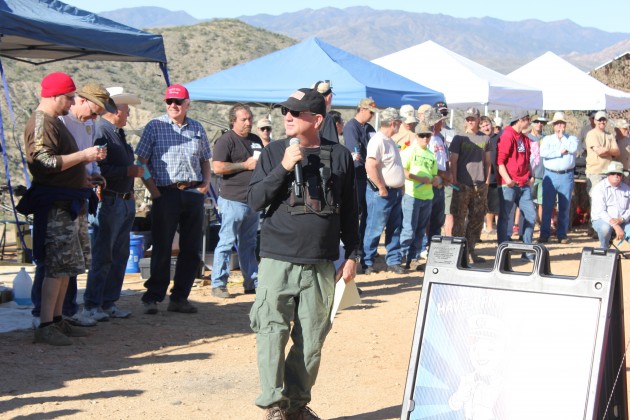
In addition to a baseball cap, some sunglasses, and hearing protection, Kenton is outfitted in a black tactical vest that holds an extra mag for the FN Five Seven he likes to carry. He spends most of the weekend driving around in a 1960s military Jeep painted in a desert camo finish with the window shield folded down. He's had it for years and used to survey Big Sandy over a decade ago when he was trying to find a home for the shoot. It became clear the Jeep hadn't lost a step over the years when he drove me out to survey the crater-riddled target area in it. It's a hell of a ride.
Did I mention he mounted a massive 20mm Lahti anti-tank gun on top of it?
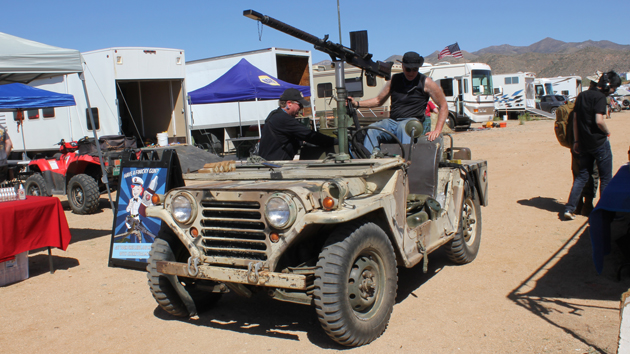
The Lahti is a rare gun which was only used for a brief period of time known as the Winter War. Between Nov. 30, 1939, and March 13, 1940, Finland fought off a Soviet invasion. It was in this brief three month action, which resulted in Finland losing about 10 percent of its territory and the Soviet Union being kicked out of the League of Nations, that the Lahti was used to destroy tanks and armored vehicles. It was quickly rendered obsolete by ever thicker and more advanced armor.
There’s likely one in a museum somewhere. Big Sandy may be the only place in the world you can still see one fire and learn about its impact on the world from somebody with a passion for it.
And it certainly isn't alone in that regard.
After a day of match shooting and a night filled with the visual and auditory fury of machine guns firing tracer rounds at explosive targets (the experience of which which vaguely resembles a heavy metal rock concert, except with machine guns laying down the bass line and explosions playing the role of a drum kit) Kenton takes me on a tour of the grounds.
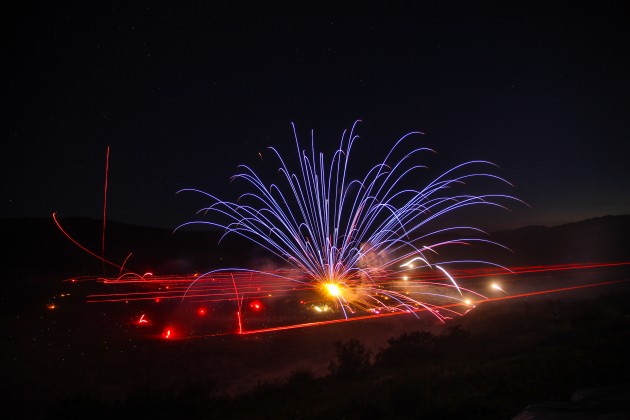
All along the firing line sits a treasure trove of rare and incredible guns. If you took any one of these guns and brought them into your local range you would likely be mobbed by curious gun owners. At Big Sandy they're all gathered together in one place and shot at the same time.
It's like the National Rifle Association's museum or the Smithsonian's gun room come to life.
There are machine guns from every era. A Civil War-era Union Gatling gun and Confederate Williams gun were situated at one end of the firing line. The Great War's Maxims, Vickers, and Madsens were all there. So was practically every machine gun John Moses Browning ever invented. There was an M14, deployed during the Vietnam war, and its replacement, the M16A1. The same can be said of the M-60 and its replacement, the M-270.
Every size and shape was represented as well, from a modest but fully automatic Ruger 10/22 chambered in .22 long rifle to the thunderous Browning M2 chambered in .50 BMG. There were machine guns that came out of airplanes or off of armored cars and tanks. Heck, they even had a line of artillery which featured cannons as big as 76 mm—that one smashed an iPad positioned too close to its muzzle with the concussion from its shot.
"You get to see guns here that are from the turn of the century," Peter Tomich, who'd driven all the way from Illinois with his friend Jake Maciejewski and paid the $25 spectators fee to watch the shoot, tells me. "We'd gone to the World War I museum in Kansas City and I was just so surprised about how many of these things I'd actually seen in person, running, that were behind this glass in a museum."
"Because these hobbyists, that's their passion," Maciejewski says. "They'll keep these guns, made in the early 20th Century, running a hundred years later."
"It's a living museum," Tomich says. "Instead of seeing it behind glass, you can actually see it work as it would have."
Ed Hope likes to call the shooters "practical historians."
"You've got this old equipment and you're trying to keep it going," he says. "It's precision equipment. You're talking the same kind of quality as a watch but these things were mass produced and they're war instruments."
"The way to preserve this history is to tell the story," Gabriel Gilmore says. "The best way to learn about guns is to talk to somebody whose carried it in combat for freaking 10 years, or somebody who’s owned it for 30 years, or the person like Dolf who wrote the book on it."
"I mean, what better sources could you have?"
A sizeable group of the guns here were collecting dust in a museum not too long ago.
When the Champlin Fighter Museum in Arizona closed its doors and moved its aircraft collection to the Museum of Flight in Seattle, Wash., it sold off a large portion of its machine gun collection to private enthusiasts. Kenton Tucker happened to be the man in charge of selling those guns and many ended up in the hands of those at the shoot.
One of those guns is an original WWII-era Type 92 Japanese machine gun. It was captured by the Marines during the battle for Guadalcanal, who then gave it to Admiral William "Bull" Halsey. For years after the war it was held by the son of one of Halsey's staff but eventually ended up in the Champlin museum and is now owned by collector Jon Blaylock.
There's also a modified German MG15 here, out of the Champlin collection. Originally an aircraft gun, the Germans modified it to be fired from the ground. "They didn't have enough machine guns," Kenton says. "So the Germans took their air guns and put a water casing around them."
"Very unorthodox but it worked."
There's a German MG42 from the Battle of the Bulge which a sergeant in the U.S. Army had captured and sent home, but only after it killed 4 members of his squad, so I’m told.
There's an Austro-Hungarian Schwarzlose which had been issued by the Austrians to German troops on the Italian front and taken by those units to the western front during a hurried redeployment in 1918. "They were in such a hurry to get them in the line to fight that they didn't have time to turn in their Austrian equipment and be reequipped with German equipment," the gun's owner 86-year-old Dolf Goldsmith says. "There was no time for that."
"So they just sent them into battle with Austrian equipment."
The gun is extremely rare today. Dolf estimates there are only about 30 in the entire country. His may be one of the only ones that still fires.
That's not the rarest gun at the Big Sandy. Even though it's a replica, the Confederate 1862 Williams gun sitting at the beginning of the firing line is a true one-of-a-kind. "The Confederacy had 21 of them," the gun's owner Bill Tjerrild says. "There's only one surviving original one. It's in the Smithsonian."
"This is an exact replica of the original and that's the only replica."
I shoot everything from a WWII-era British Sten gun to a modern American M-270, a late model M16A4, a WWII-era Browning Automatic Rifle (better known as the B.A.R.), a Vietnam-era M-60 (aka Rambo's gun), and a WWII-era German MG-42 (nicknamed Hitler's buzz saw due to the sound it makes when fired). I feel the sizable kick of a fully automatic short barreled AK-47. I fire exotic semi-automatic rifles like a California-legal Barret Model 82A1 .416 (which shoots like a dream and kicks like a mule) and an Armalite .50 caliber AR-50 sniper rifle (which kicks like a horse). I get to run through a competition match with a WWI-era bolt action Springfield 1903.
I even fire a WWI-era Maxim machine gun, the first true machine gun.
The Maxim I shoot was originally manufactured in 1918 and still works to this very day, nearly a century later. That's because Goldsmith, the gun’s owner, has become an expert at maintaining it. As Gabriel Gilmore said, he literally wrote the book on the Maxim.
And Dolf is far from the only one at Big Sandy who knows his guns inside and out.
The effort that goes into legally owning one of these guns and keeping them in working order is nearly as impressive as the guns themselves. Thanks to the National Firearms Act of 1934 and the Gun Control and Safe Streets Act of 1968 every machine gun owner at Big Sandy has had to register every one of their fully automatic guns with the Bureau of Alcohol, Tobacco, Firearms, and Explosives (ATF), submit to extensive background checks and fingerprinting, pay a $200 tax, fill out a mountain of paperwork, and endure long waiting periods. The shooters who traveled to the shoot from other states like Florida and Mississippi had to get approval from the ATF in order to cross state lines with their guns.
It's a 1986 amendment to the Firearms Owners' Protection Act that makes purchasing a machine gun so difficult. That amendment effectively banned civilian ownership of fully automatic firearms manufactured after 1986. That caused machine gun prices to skyrocket.
While many of the older collectors had been able to buy machine guns for a couple hundred or a few thousand dollars before the ban, today it's nearly impossible to break into the market for less than 5 figures. Some of the less common guns can run hundreds of thousands of dollars. "There's probably something like 10 or 20 million dollars worth of guns here," Ed Hope says.
Of course, buying the guns themselves is just the first step. A number of these guns are old enough that modern ammunition manufacturers don't produce rounds for them anymore. Most of the shooters end up running old military surplus rounds or ammunition they've reloaded themselves. Dolf is running 60-year-old ammunition through his 90-year-old Maxim.
Good luck finding replacement parts for some of these guns. And if your weapon malfunctions the gun smith at your local shop is unlikely to know how to fix it. So, you'd better be versed in exactly how your machine gun works or know somebody who can help you. I suppose that's likely why many of the shooters at Big Sandy have an abundance of knowledge and friends along the firing line.
The atmosphere at Big Sandy is more like a family reunion than a machine gun festival. There are other machine gun shoots throughout the country, most notably at Knob Creek in Kentucky, but a number of shooters here tell me that this one caters more to enthusiasts. It's a true shooters shoot, and everybody on the line seems to know and care for each other.
There's a real community that's formed between these people from all over the country and, in some cases, all over the world.
"We've got pilots, we've got doctors, and we've got cops," Sondra Stepper says. "We're committed to the history. We’re committed to sharing it with others. And on top of that we have a camaraderie."
"We're not crazy people. We're not fanatics. We're enthusiasts."
This becomes especially apparent after the shooting dies down and the camping phase kicks in. Once everybody settles in for the night they gather together at their RVs or around a fire by their campsites. They cook each other food. They share water and soda and booze with each other. They tell jokes. They talk about politics. They share stories about their lives. They catch up. They're quick to adopt new people into their group: They help me set up my tent and fill up my air mattress, let me shoot their guns, and even give me an extra blanket to keep me from getting too cold in the 40 degree desert night.
I see the same thing in the daytime and with others. As I finish interviewing Bill Tjerrild about his Confederate Williams gun a new shooter approaches him for advice. He'd just bought his first cannon and Tjerrild spends the next 20 minutes walking him through the best practices.
"We share knowledge," Stepper says.
"We want them to succeed," Gilmore chimes in. "We want our clique to grow."
"We don't want them to learn the hard way like some of our friends have," Stepper says.
Many of the shooters' generosity extends well beyond sharing knowledge. During my three days at Big Sandy I shoot several hundred thousand dollars worth of firearms.
"When you hand somebody your expensive camera you say 'oh hold on, don't drop it,' and it's like a $2,000 camera," Gilmore says. "Here you're handing somebody a quarter of a million dollar rifle?"
"You're talking about trust. People don't trust you with a camera and basically I'm handing you the keys to my Ferrari, my Diablo, and saying 'have at it.'"
Big Sandy participants also provide support to the local community. The 4H club sells breakfast, lunch, and dinner to the crowd and gets to keep the proceeds. The Young Patriots Corps, a group aimed at helping kids from troubled backgrounds, brings a group to the shoot and raises the flag every morning.
There is a raffle with half the proceeds going to local charities. The other half goes to one lucky winner. This year's raffle winner, Lorin Kramer, immediately gives his winnings to the wife of a shooter who had recently been diagnosed with cancer.
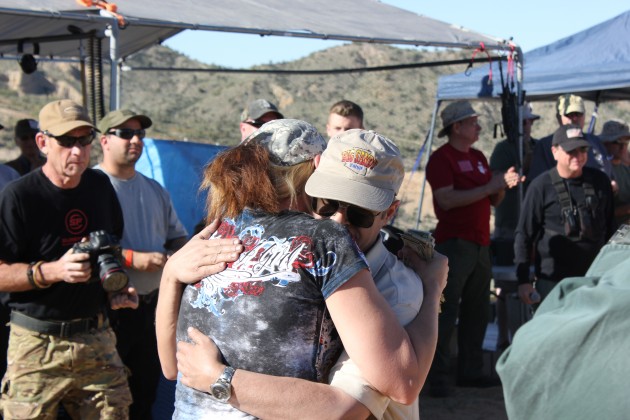
I leave the desert feeling like I've gained a good deal, and not just a ringing in my ears.
